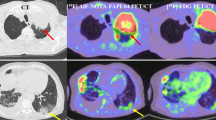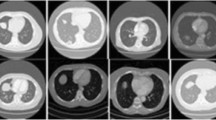Abstract
Objectives
To investigate the effects of slice thickness on CT radiomics features and models for staging liver fibrosis.
Methods
A total of 108 pathologically confirmed liver fibrosis patients from a single center were retrospectively collected and divided into different groups. Both thick (5- or 7-mm) and thin slices (1.3- or 2-mm) were analyzed. A fivefold cross-validation with 100 repeats was conducted. The minimum redundancy–maximum relevance algorithm was used to reduce the radiomics features, and the top 10 ranking features were included for further analysis for each loop. The random forest was used for model establishment. The models with median AUC were selected for the assessment of the discriminative performance for both datasets. Mutual features selected by the models with AUC > 0.8 were searched and considered as the most predictive ones.
Results
A total of 162 and 643 radiomics features with excellent reliability were selected from thick- and thin-slice datasets, respectively. The overall discriminative performance of the 500 AUCs from the thin-slice dataset was better than the thick slice. The median AUC values of the thick-sliced datasets were significantly lower than those of the thin-sliced datasets (0.78 and 0.90 for differentiating F1 vs. F2–4, 0.72 and 0.85 for differentiating F1–2 vs. F3–4, both P = 0.03). For differentiating F1–3 vs. F4, no significant difference was found (0.85 vs 0.94, P = 0.15). Six mutual predictive features across all the datasets were found.
Conclusions
The radiomics features extracted from thin-slice images and their corresponding models were better and more stable for staging liver fibrosis.




Similar content being viewed by others
References
Scott R, Guha IN. Non-invasive monitoring of liver fibrosis. Br Med Bull. 2014;112(1):97–106.
Beasley RP. Hepatitis B virus. The major etiology of hepatocellular carcinoma. Cancer. 1988;61(10):1942–56.
Chang TT, Liaw YF, Wu SS, Schiff E, Han KH, Lai CL, et al. Long-term entecavir therapy results in the reversal of fibrosis/cirrhosis and continued histological improvement in patients with chronic hepatitis B. Hepatology. 2010;52(3):886–93.
Ellis EL, Mann DA. Clinical evidence for the regression of liver fibrosis. J Hepatol. 2012;56(5):1171–80.
Bedossa P, Dargere D, Paradis V. Sampling variability of liver fibrosis in chronic hepatitis C. Hepatology. 2003;38(6):1449–57.
Cadranel JF, Rufat P, Degos F. Practices of liver biopsy in France: results of a prospective nationwide survey. For the Group of Epidemiology of the French Association for the Study of the Liver (AFEF). Hepatology. 2000;32(3):477–81.
Kumar V, Gu Y, Basu S, Berglund A, Eschrich SA, Schabath MB, et al. Radiomics: the process and the challenges. Magn Reson Imaging. 2012;30(9):1234–48.
Lambin P, Rios-Velazquez E, Leijenaar R, Carvalho S, van Stiphout RG, Granton P, et al. Radiomics: extracting more information from medical images using advanced feature analysis. Eur J Cancer. 2012;48(4):441–6.
Hu P, Hu X, Lin YD, Yu XJ, Tao XW, Sun JH, et al. A combination model of radiomics features and clinical biomarkers as a nomogram to differentiate nonadvanced from advanced liver fibrosis: a retrospective study. Acad Radiol. 2021. https://doi.org/10.1016/j.acra.2020.08.029.
Lubner MG, Malecki K, Kloke J, Ganeshan B, Pickhardt PJ. Texture analysis of the liver at MDCT for assessing hepatic fibrosis. Abdom Radiol. 2017;42(8):2069–78.
Lubner MG, Jones D, Kloke J, Said A, Pickhardt PJ. CT texture analysis of the liver for assessing hepatic fibrosis in patients with hepatitis C virus. Br J Radiol. 2019;92(1093):20180153.
Cui E, Long W, Wu J, Li Q, Ma C, Lei Y, et al. Predicting the stages of liver fibrosis with multiphase CT radiomics based on volumetric features. Abdom Radiol. 2021;46(8):3866–76.
Wang JC, Fu R, Tao XW, Mao YF, Wang F, Zhang ZC, et al. A radiomics-based model on non-contrast CT for predicting cirrhosis: make the most of image data. Biomark Res. 2020;8:47.
Budai BK, Toth A, Borsos P, Frank VG, Shariati S, Fejer B, et al. Three-dimensional CT texture analysis of anatomic liver segments can differentiate between low-grade and high-grade fibrosis. BMC Med Imaging. 2020;20(1):108.
Zhang X, Gao X, Liu BJ, Ma K, Yan W, Liling L, et al. Effective staging of fibrosis by the selected texture features of liver: which one is better, CT or MR imaging? Comput Med Imaging Graph Off J Comput Med Imaging Soc. 2015;46(Pt 2):227–36.
Chinese Society of Infectious Disease and Parasitology and Chinese Society of Hepatology of Chinese Medical Association. The programme of prevention and cure for viral hepatitis. Zhonghua Ganzangbing Zazhi. 2000;8(6):324–9 (in Chinese).
Pickhardt PJ, Graffy PM, Said A, Jones D, Welsh B, Zea R, et al. Multiparametric CT for noninvasive staging of hepatitis C virus-related liver fibrosis: correlation with the histopathologic fibrosis score. AJR Am J Roentgenol. 2019;212(3):547–53.
Park S, Lee SM, Do KH, Lee JG, Bae W, Park H, et al. Deep learning algorithm for reducing CT slice thickness: effect on reproducibility of radiomic features in lung cancer. Korean J Radiol. 2019;20(10):1431–40.
Zhao B, Tan Y, Tsai WY, Qi J, Xie C, Lu L, et al. Reproducibility of radiomics for deciphering tumor phenotype with imaging. Sci Rep. 2016;6:23428.
Hu HT, Shan QY, Chen SL, Li B, Feng ST, Xu EJ, et al. CT-based radiomics for preoperative prediction of early recurrent hepatocellular carcinoma: technical reproducibility of acquisition and scanners. Radiol Med. 2020;125(8):697–705.
Kolossvary M, Park J, Bang JI, Zhang J, Lee JM, Paeng JC, et al. Identification of invasive and radionuclide imaging markers of coronary plaque vulnerability using radiomic analysis of coronary computed tomography angiography. Eur Heart J Cardiovasc Imaging. 2019;20(11):1250–8.
Acknowledgements
This study was supported by National Key R&D Program of China (2018YFE0114800), Key Research and Development Program of Zhejiang Province (2019C03014), Nature Foundation of Zhejiang Province (LGF22H180008) and the National Natural Science Foundation of China (81871403).
Author information
Authors and Affiliations
Corresponding author
Ethics declarations
Conflict of interest
The authors declare that there is no conflict of interest and do not have any financial relationship with any sponsoring organization.
Ethical approval
All the procedures performed in studies involving human participants were in accordance with the ethical standards of the institutional and/or national research committee and with the 1964 Helsinki Declaration and its later amendments or comparable ethical standards.
Informed consent
This retrospective study was approved by the institution’s Committee on Human Research, and the need for obtaining written informed consent was waived.
Additional information
Publisher's Note
Springer Nature remains neutral with regard to jurisdictional claims in published maps and institutional affiliations.
About this article
Cite this article
Hu, P., Chen, L., Zhong, Y. et al. Effects of slice thickness on CT radiomics features and models for staging liver fibrosis caused by chronic liver disease. Jpn J Radiol 40, 1061–1068 (2022). https://doi.org/10.1007/s11604-022-01284-z
Received:
Accepted:
Published:
Issue Date:
DOI: https://doi.org/10.1007/s11604-022-01284-z




